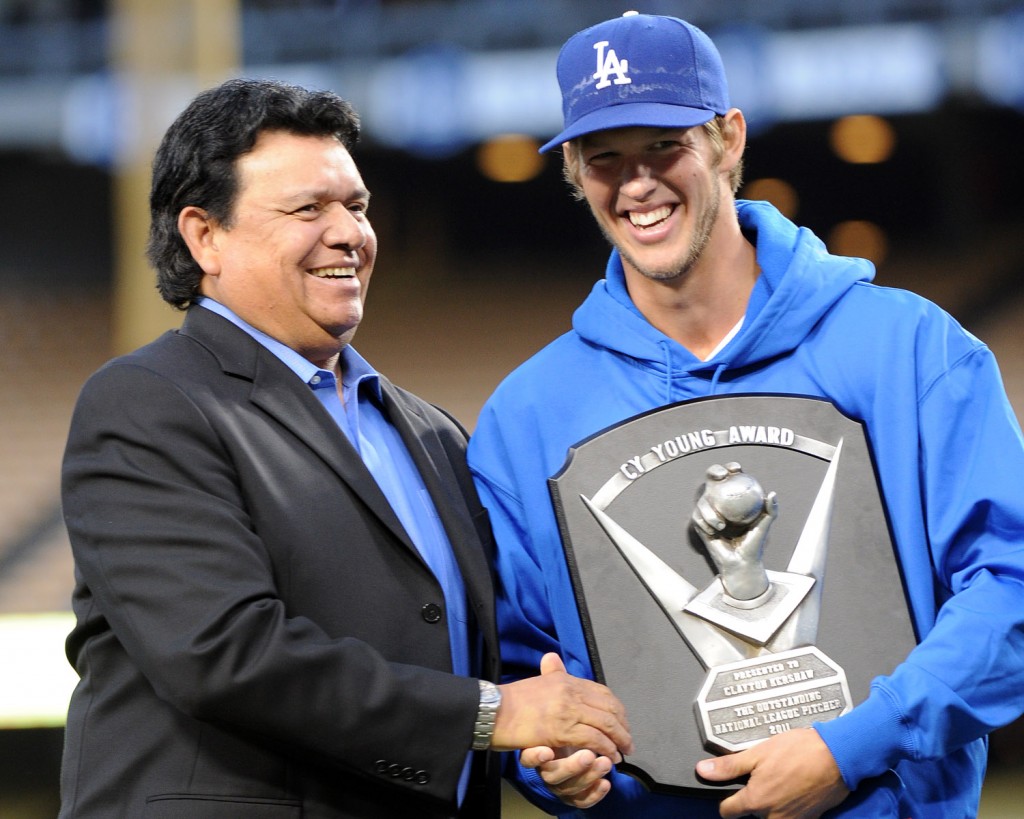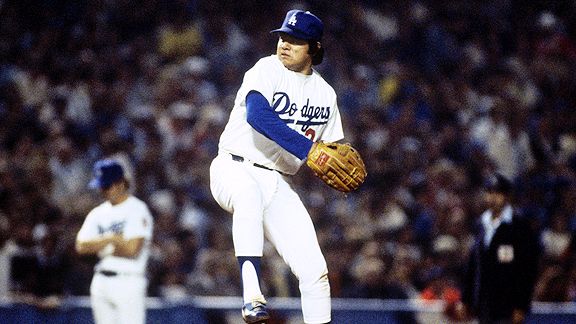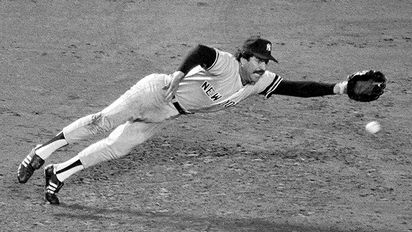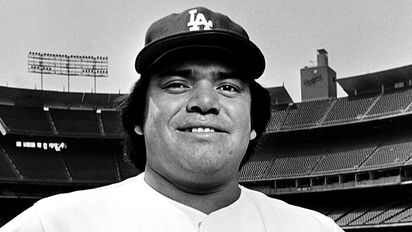Tag: Fernando Valenzuela (Page 3 of 3)
Today is the 30th anniversary of Fernando Valenzuela’s first start in the majors, the 2-0 Opening Day shutout that launched Fernandomania.
But I’m going to take this occasion to focus on a different start, one that I think came to define Valenzuela as much as Fernandomania did, if not more: Game 3 of the 1981 World Series.
At age 20, Valenzuela sizzled through the first eight starts of his career like no one we’d ever seen, but the story of his career was one of perseverance. In fact, even on Opening Day 1981, Valenzuela allowed baserunners in five of his first six innings, including runners on second and third with one out in the sixth inning of a 1-0 game.
But nothing captured Valenzuela’s endurance like his marathon in the ’81 Series, played before what at the time was the largest recorded attendance at Dodger Stadium, a legitimate 56,236.
Thanks to indispensable friend of Dodger Thoughts Stan Opdyke, I was able to listen to the radio broadcast of the October 23, 1981 game, with play-by-play by Vin Scully and color commentary by Sparky Anderson. It was a resplendent broadcast, full of detail to match any televised high-def TV closeup, a broadcast that really brought home how Valenzuela struggled and survived.
‘The worst’
The Dodgers had lost six consecutive World Series games, all to the Yankees, when the two teams met at Dodger Stadium on this night. Valenzuela had most recently pitched 8 2/3 innings in the Dodgers’ National League Championship Series’ clincher won by Rick Monday’s ninth-inning home run, so he wasn’t new to pressure. But keep in mind also that he was throwing in the World Series on three days’ rest. (The World Series started barely 24 hours after the NLCS ended.)
Scully was on his game well before Valenzuela, who walked leadoff hitter Willie Randolph on a ball four that was way outside and, one out later, also walked Dave Winfield. Cleanup hitter Lou Piniella hit a 6-4-3 double-play grounder which Davey Lopes turned despite the onrushing presence of Winfield, who didn’t slide. “Davey Lopes had Dave Winfield coming at him like some Redwood Tree,” Scully said, later adding, “It was as if Davey was trying to throw over the Empire State Building.”
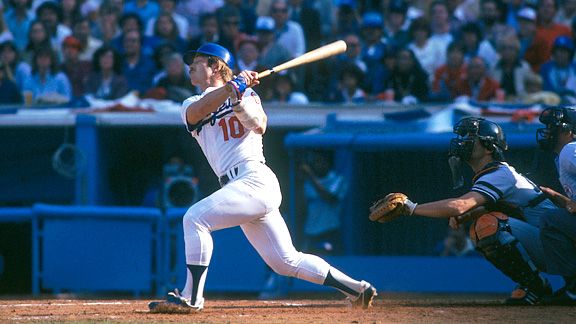
Ron Cey, shown here in a later Series game, put on an offensive and defensive showcase in Game 3. (Getty Images)
The Dodgers, who had yet to lead in the Series, finally took the upper hand in the bottom of the first. Lopes doubled, and a perfectly placed Russell bunt put runners on first and third. A struggling Dusty Baker popped out and Steve Garvey struck out, but Ron Cey drove a 2-2 fastball from the game’s other rookie starting pitcher, Dave Righetti, over the left-field wall for a 3-0 lead.
“I’ve seen him hit more good high fastballs out of the park than you’d ever want to see,” said Anderson, the former Cincinnati Reds manager who had moved on to Detroit.
Los Angeles had a chance to pad the early lead when Pedro Guerrero was hit by a pitch and Rick Monday drove him to third on a hit-and-run single, but Steve Yeager popped out.
Valenzuela had his shutout for only one more pitch. Bob Watson drilled an 0-1 offering to center. “Going in on the ball is Guerrero,” Scully said, “and it goes into the seats for a home run! That’s how hard Watson hit the ball.”
The next hitter, Rick Cerone, doubled down the left-field line directly off the railing, with Yankees manager Bob Lemon arguing for a home run. Six Yankee batters into the game, the Dodger bullpen began warming up for the first time, starting with Dave Goltz. Aurelio Rodriguez flied out, but Larry Milbourne (playing for the injured Bucky Dent) singled home Cerone to cut the Dodger lead to 3-2.
After a Righetti sacrifice, Valenzuela walked Randolph again before getting out of the second inning on a comebacker.
Righetti was faring little better. He walked Valenzuela to lead off the bottom of the second inning. Lopes bunted Valenzuela to second base, prompting Scully to ask Anderson how concerned the Dodgers should be about Valenzuela being out on the bases. Anderson didn’t seem to think there was much to worry about. Valenzuela went to third base on a Russell groundout, but stayed there when Baker popped out for the second time in two innings.
To start the third, Valenzuela kindled hopes that his worst was behind him when he struck out Winfield. “That’s the first true Valenzuela screwball I’ve seen tonight,” Scully commented. But Piniella singled. Lopes briefly saved Valenzuela with an over-the-shoulder catch of a Watson blooper, but Cerone, who narrowly missed a homer in his previous at-bat, left no doubt this time, whacking a screwball over the wall in left-center to give New York a 4-3 lead.
By this time, Scully couldn’t avoid the reality.
“This might be the worst game I’ve ever seen Valenzuela pitch,” he said.
Batting for Valenzuela …
Valenzuela’s troubles continued with the next batter. Rodriguez reached second base on an infield single that Lopes threw into the photographers’ well. That compelled Dodger manager Tommy Lasorda to have Valenzuela walk Milbourne intentionally, so that he could use Righetti as an escape valve with a strikeout.
Still, to this point, Valenzuela had allowed 10 baserunners in three innings, surrendering the Dodgers’ early lead while throwing no fewer than 71 pitches. Said Scully of the crowd, “That wave of enthusiasm has suddenly crashed upon the shores.” Anderson, meanwhile, wondered whether New York fans might have misgivings of their own. “The Yankees, you know, have left five (runners), so they could have torn this thing wide open.”
Righetti remained wobbly. When Garvey singled on a 3-2 pitch to lead off the bottom of the fourth, George Frazier began warming up in the Yankee bullpen for the third time, and when Cey walked, Frazier was called in.
Lasorda did his best to make Frazier feel comfortable by asking Guerrero to bunt. He had three sacrifices in the 1981 regular season and hit into four double plays in the NLCS, but the idea of it still raises howls. Not surprisingly, Guerrero flailed twice and then struck out.
Scully: “That must kill you (as a manager).”
Anderson: “The bunt, I promise you Vinny, over the course of the whole season will cost you more runs than any play we do. Bad baserunning and bunting will kill more rallies than any other thing in the game.”
After Monday flied out, Lasorda made an even bolder move, pinch-hitting Mike Scioscia for Yeager in the third inning. Scioscia grounded to short, and the Dodgers remained behind by a run.
Because he was due to lead off the bottom of the fourth inning, Valenzuela was pitching to stay in the game at this point. He responded with his best inning so far that night, retiring the side on 12 pitches, though even then, he walked Winfield with two out and had to survive a Piniella liner to Baker to left.
Subsequently, a leadoff double in the top of the fifth inning by Watson caused Tom Niedenfuer to begin warming up, but two outs and another intentional walk to Milbourne later, Frazier was left to bat for himself by the same manager who would infamously hit for Tommy John in Game 6. Frazier struck out, stranding the Yankees’ seventh and eighth runners of the game.
In the bottom of the fifth, Garvey reached first on an infield single that Rodriguez (starting in place of an injured Graig Nettles) did well to keep from becoming a double. Cey walked on a 3-2 pitch. Once again, Guerrero was up with two on and no outs, but this time, the bunt was off. Guerrero hit a big chopper over Rodriguez’s head for an RBI double that tied the game.
Monday was walked intentionally to load the bases for Scioscia with none out. As lefty Rudy May came in to face the Dodger catcher, Reggie Smith came out on deck to hit for Valenuela, whose night appeared over after five innings and 95 pitches. Steve Howe was throwing in the Dodger bullpen.
Scully and Anderson agreed that Scioscia did the one thing to keep Valenzuela in the game. He grounded into a double play, driving in the go-ahead run while putting two outs on the board. With more baserunners or fewer outs, the announcers believed that Lasorda surely would have pulled Valenzuela, but with two out and a runner on third, the manager decided to stick with his pitcher. What’s interesting is that for all his struggles, Valenzuela’s walk to the batter’s box earned roars of delight from the crowd.
Valenzuela grounded to short, stranding the Dodgers’ sixth runner. But he headed into the sixth inning staked once more with a lead. This time, could he hold it?
‘If that don’t help him, nothing will.’
If you can believe it, Valenzuela went back out on that hill and walked the first batter he faced – Randolph for a third time. Lasorda immediately came out to the mound to talk to Valenzuela. Niedenfuer and Howe were up in the bullpen. “No command of the breaking ball,” said Scully.
Valenzuela was truly at the end of his rope.
And then, Scioscia saved his pitcher again – this time, in a more positive fashion. Randolph broke for second on a steal, and Scioscia nailed him.
“That’s a big play right there for Fernando,” Anderson exclaimed. “If that don’t help him, nothing will.”
It did help him. Jerry Mumphrey struck out on three pitches, Winfield grounded to third, and Valenzuela completed his third consecutive 12-pitch inning. For the first time all night, he put up a zero while the Dodgers had the lead.
The seventh was positively svelte for Valenzuela, though not without a scare. He retired the side in order on 10 pitches, but not before the middle batter, Watson, belted one to the left-field wall, where Baker caught it. In a precursor to his famous line that capped Valenzuela’s no-hitter nine years later, Scully said of the hanging curve to Watson, “You could have hung your sombrero on that one.”
The Dodgers certainly weren’t doing much in the way of providing insurance runs. In the bottom of the seventh, Cey (who went 2 for 2 with two walks) singled to become the sixth Dodger to reach base leading off an inning. But Guerrero struck out, and just as Anderson had finished describing Derrel Thomas (batting for Monday) as someone “of limited ability who has made the most of it,” Thomas hit into a double play.
The top of the eighth featured what might have been the definitive defensive play in the nine years of the Garvey-Lopes-Russell-Cey infield. Rodriguez and Milbourne started off the inning with singles, becoming the 15th and 16th batters to reach base off Valenzuela, compared with 21 outs. Bobby Murcer, a 35-year-old veteran, came up to pinch-hit. (Dodger nemesis Reggie Jackson was on the Yankee bench with an injury suffered running the bases in Game 2, and though it was believed he was healthy enough to bat, he did not.)
On the first pitch he saw, Murcer squared to bunt – and popped it in the air, foul. Cey came charging in … and made a remarkable diving catch, before doubling up Milbourne off first base. The Dodger Stadium crowd let out a deafening roar.
Valenzuela then came within a pitch of walking Randolph for a fourth time, before the future Dodger hit a difficult ground ball to Cey. It would have been an infield single – if Rodriguez had held back at second base. But he came close enough to third for Cey to tag him directly.
Scully simply marveled.
“I tell you what (Valenzuela) is doing – a high-wire act in a windstorm,” he said.
El Toro
When Scioscia singled to start the bottom of the eighth (yes, another leadoff hitter aboard), Valenzuela took his bat up to home plate. He had now been nursing a one-run lead for three innings, and had thrown 131 pitches in the game. And thanks to Scioscia’s lack of speed, Valenzuela would spend the rest of the eighth inning standing at first base after bunting into a force play.
Lopes struck out and Russell popped out, and Valenzuela quickly prepared for his final inning on the mound. Dave Stewart joined Howe in the bullpen – by this time, it seemed the only pitcher that hadn’t gotten ready to relieve for the Dodgers was Lasorda himself.
Six Yankees had reached base at least twice against Valenzuela. Mumphrey, the only position player who hadn’t reached at all, grounded to Lopes on a 2-2 pitch. Two outs to go.
Winfield, whose World Series lack of performance would become the stuff of Steinbrennerian legend, hit a high drive to right-center field. Thomas and Guerrero converged, and Guerrero made the catch. One out to go.
Piniella came to bat. “Garvey on the line at first,” Scully said, “Cey on the line at third, and the ballgame on the line.”
Tempting fate one last time, Valenzuela fell behind in the count, 2-0. A called strike, and then a foul.
Valenzuela wound up and threw his 146th pitch of the October evening.
“Fastball – got him swinging!” Scully exclaimed.
Scully immediately recognized and conveyed what the night meant.
“This was not the best Fernando game. It was his finest.”
Valenzuela, this game showed, was in it for the long haul. He pitched in the majors until 1997, and tales of him going back to pitch in Mexico have been recorded to this very year. El Toro was simply as tough as they come.
Highlights:
- Aaron Miles went 2 for 2.
- Corey Smith hit a ground-rule double to dead center. In 14 plate appearances this spring: two singles, two doubles, two homers, four walks, four outs, 2.114 OPS. Smith, a third baseman who turns 29 next month, is shaping up to be this year’s John Lindsey. He’s an 11-year minor-league veteran who has never reached the majors.
Lowlights:
- Chad Billingsley allowed a single, a walk, a hit batter and a double in a two-run second inning.
- Ivan DeJesus Jr. was called out on strikes with two on and two out in the third.
Sidelights:
- Ramon Troncoso was sent to the minors. As Tony Jackson of ESPNLosAngeles.com says, the final spot in the bullpen is a two-man competition between lefty Scott Elbert and righty Lance Cormier. If the Dodgers were going on last year’s performance, however, Cormier would be a lock ahead of Mike MacDougal, who has apparently made the team. That being said, Cormier did walk more than he struck out last year as well.
- Dylan Hernandez of the Times is suggesting that the Dodgers are now considering going to a fifth starter on April 10, to give Clayton Kershaw and Billingsley an early extra day of rest, and aree lining up Tim Redding for the slot.
- Jerry Crowe of the Times tells the story of how Mike Brito discovered Bobby Castillo, which of course had a major effect on Fernando Valenzuela’s path in Los Angeles.
Former Dodger great Fernando Valenzuela is being inducted into the Latino Baseball Hall of Fame and is flying to the Dominican Republic for the ceremony Saturday.
Valenzuela is part of the LBHoF’s second class, and will be joined by Luis Tiant, Dennis Martinez, Manny Sanguillen, Edgar Martinez, Rico Carty and Andres Galarraga. Dodger broadcaster Jaime Jarrin was part of the inaugural class, while longtime Dodger scout Ralph Avila helped found the LBHoF.
Two days earlier, on Thursday, Dodger prospects from the team’s Campo Las Palmas training facility will play Yankees prospects in the Latino Baseball Hall of Fame Cup in La Romana. A statue of Valenzuela will be unveiled in La Romana on Friday as part of the “Paseo de los Inmortales del Salón de la Fama del Béisbol Latino.”
“I’m happy to make my first trip to the Dominican Republic, a country that has a long history with the Dodgers and where the club has placed a lot of importance in baseball development through Campo Las Palmas,” Valenzuela said in a statement. “I’m even more pleased that I’m here for such a grand occasion. It’s an honor to represent the Dodgers in the Latino Baseball Hall of Fame.”
The Steinbrenner family is receiving the Tommy Lasorda Award, an honor given by the LBHoF to non-Latinos that advance Latin-American interests in the game.
Dominican Republic president Dr. Leonel Fernandez Reyna will preside over the ceremony in La Romana.
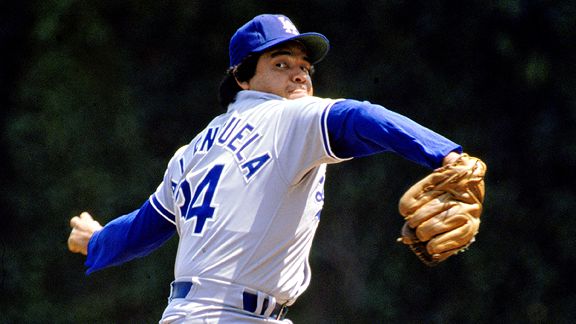
Ron Vesely/Getty ImagesFernando Valenzuela
Fernando Valenzuela’s April and May in 1981 were something you felt inside you, like a superpower. And that’s just if you were a 13-year-old white kid in the Valley.
If you shared a common heritage with Valenzuela, as Cruz Angeles emphasizes in “Fernando Nation,” which premieres Tuesday on ESPN, Valenzuela’s arrival was like the birth of the Justice League.
Angeles’ documentary on Valenzuela has a lot of ground to cover – it won’t surprise Dodger fans how inadequate 50 minutes is to do the job – but he gets across the depths Valenzuela rose from, the heights he soared and the impact he had on people he didn’t know personally but who had a powerful connection to him.
The personal story of Valenzuela isn’t lost amid the bigger picture. “When I was a child, we didn’t have any dreams,” Valenzuela recalls in the documentary’s opening minutes. After Valenzuela became a sensation in 1981, KABC Channel 7 raced to provide the dusty reality of the remote Mexican village he was raised in, a world away from the United States. But rather than aimlessness, that absence of expectation sowed in Valenzuela a discipline. “I just wanted to get better, step by step,” Valenzuela remembers thinking, even in his pre-teen years.
But as Angeles takes pains to illustrate, Valenzuela wasn’t a mere mascot for the Mexican, Latino or Chicano communities. He was something cathartic, something euphoric, to heel wounds that had been felt by some for decades.
Angeles mostly does well articulating the controversial displacement of the residents of Chavez Ravine in the 1950s, including the key issue of how the new public housing, playgrounds and schools that had been promised for that area as early as 1949 was eventually scuttled after one of its principal advocates, assistant housing director Frank Wilkinson, was swept up in the Red Scare. (Details of this are in Chapter 11 of “100 Things Dodgers Fans Should Know & Do Before They Die.“) It can’t be emphasized enough that most of the damage to people in this area occurred before Walter O’Malley had even heard of it.
The narrative in “Fernando Nation” plays things a little looser after O’Malley gets involved, directly connecting him and the construction of Dodger Stadium with the forced evictions of the area’s remaining denizens, even though those evictions were in the cards regardless of whether the Dodgers ever left Brooklyn. It is documented that Los Angeles would act in broad strokes with the area (which it bought back from the United States, on the condition that it be used for a public purpose, after the public housing contracts were canceled). A baseball stadium was but one of multiple possible outcomes, all of which meant taking full control of the land.
Nevertheless, even if the fine print absolves the Dodgers of responsibility for what happened at Chavez Ravine, there’s no mistaking what the lingering perception was for many: Dodger Stadium was on their land. And the ill will, Angeles notes, only deepened with the rise of the Chicano (Mexican-American, to oversimplify) movement in the late 1960s. To make this clear, Angeles uses archived footage of police brutality at a Chicano rally, including a cop clubbing a female bystander in the back, that makes the Rodney King incident almost look like childs’ play.
Even after Fernandomania began, issues of ethnicity and nationality remained alive; Angeles includes a clip from “The Tonight Show with Johnny Carson” in which the host cracks with regard to the 1981 players’ strike, “Reggie Jackson offered Fernando Valenzuela a job as a gardener.” Valenzuela is later called in a news report “Mexico’s most documented migrant.” And when Valenzuela held out for a bigger raise during Spring Training 1982 (like Sandy Koufax and Don Drysdale in 1966, or for that matter Zack Wheat in the Prohibition Era), a government official pointedly comments that Valenzuela is in the country on a restricted visa dependent on his employment.
At the Q&A that followed Thursday’s premiere screening, one audience member asked Angeles why he had to bring such negativity into the Valenzuela documentary, considering how positive an experience Valenzuela was. Angeles responded that he didn’t see his inclusion of the history as a negative, believing that by understanding it, you see even more clearly the wonder of Valenzuela’s impact. The history is something to embrace, Angeles believes. It’s why nothing will ever be like Fernandomania.
And certainly, there is no shortage of joy in the program, especially as Valenzuela runs off to his 8-0, 0.50 start in ’81. “It is incredible, it is fantastic,” Vin Scully gasps in wonder. “Fernando Valenzuela – he has done something I can’t believe he has done or anyone will do.” Dodger fan Paul Haddad, whose childhood cassette tapes provide much of the primary-source audio for “Fernando Nation,” comments that “I was getting to experience my own Babe Ruth.” Viewers of “Fernando Nation” will truly revel in Valenzuela taking the nation by storm.
If there is a negative that is glossed over in the documentary, it is how quickly Valenzuela came back from the stratosphere to become mortal. Everyone knows what Valenzuela did in his first eight starts, but in his second eight (the final two of those coming after the strike was settled), he had one victory and a 6.46 ERA, averaging under six innings per start. (John Ely, anyone?)
Of course, Valenzuela recovered to have more great moments (such as the 1981 World Series complete game, of which Scully said, “This was not the best Fernando game, it was his finest.”) and great seasons. Valenzuela was also a wonder with the bat and the glove as a pitcher. What you’re left with is the impression that has always been an indispensable part of the Valenzuela story: He had the goods – the tools, the preternatural ability to learn the screwball from Bobby Castillo, the determination – but worked to be great.
Because of the time constraints and all the time spent discussing the birth of Fernandomania, “Fernando Nation” races to cover the later years of Valenzuela’s career – and in its depiction of Valenzuela’s 1990 no-hitter, there’s an omission in the documentary that’s nothing short of startling. But the documentary is nonetheless a success, because it leaves you, once more, with that unbridled feeling of superpower coursing through you. Fernando Valenzuela, sweetness.
Yankees at Rangers, 5:07 p.m.
* * *

Fernando Valenzuela with Cruz Angeles (right)
OK, I’m just going to get this out of the way right now: Fernando smiled at me. I mean, he charmed the living daylights out of me.
Forgive me for acting like a lovestruck teen (or twentysomething, or thirtysomething … I’ve been through it all), but I mean, it was that nice a smile.
I wasn’t expecting it. I attended Thursday’s premiere screening of “Fernando Nation,” the ESPN “30 for 30” documentary directed by Cruz Angeles that will debut on the small screen Tuesday. Valenzuela was the guest of honor. After the screening, during the Q-and-A, I asked a question of the director that I really wanted to ask Valenzuela — in fact, part of the reason I asked was the hope that Valenzuela might step in and answer it. And he did.
The question related to how Valenzuela had handled the crush of attention that came during his rookie season and how he kept it from overwhelming him. Angeles first said he believes that Valenzuela’s family taught him the discipline to handle the challenge. Then, Valenzuela was handed the microphone. Here’s part of his response:
“I think when I decided to play this game, I knew a lot of things were going to happen,” Valenzuela said. “My first year with the Dodgers was the hardest year for me. I wanted to practice with the team; I wanted to be with the team. I wanted to just enjoy the game. … (But) I had it in my head that’s part of the game. I tried to do my best; I tried to take care of everyone.
“Also, I liked that year. That happens only once in life. It happened to me in ’81. I enjoyed it.”
As he answered, looking at me as he spoke, that was when that big smile came across his face. It didn’t have anything to do with me, it was just him enjoying the memory, or the moment of talking about the memory. But it really, really made me happy.
I don’t suspect I’m explaining this adequately. But I’m never going to forget that smile.
I’ll have more about the documentary in a separate post.
Rangers 7, Yankees 2, 6th inning
Giants at Phillies, 4:57 p.m.
To celebrate today’s matchup between Tim Lincecum of the Giants and Roy Halladay of the Phillies, here’s a look at how Cy Young winners for the Dodgers performed in their postseason careers:
- Don Newcombe (1956): Newcombe famously lost a 1-0 start in Game 1 of the 1949 World Series on Tommy Henrich’s bottom-of-the-ninth home run despite allowing only five baserunners and striking out 11. Subsequent to that, Newcombe appeared in another 1949 World Series game, one in 1955 and two in 1956, and allowed 20 runs in 14 innings.
- Don Drysdale (1962): After a two-inning relief appearance in 1956 at age 20, Drysdale made six postseason starts. Three he won in dominant fashion, including a three-hit, nine-strikeout shutout of the Yankees in 1963. He took a hard-luck, 1-0 loss in the final game of the ’66 sweep by Baltimore, and was hammered in two other starts, including the apochryphal “Why couldn’t you be Jewish too?” start on Yom Kippur, 1965.
- Sandy Koufax (1963, 1965, 1966): The amazing Koufax allowed only six earned runs in 57 career postseason innings (0.95 ERA). In seven postseason starts, Koufax pitched two shutouts and four complete games. The only time he allowed a second earned run in a game, he struck out 15.
- Mike Marshall (1974): Marshall pitched in two National League Championship Series games and all five World Series games for the Dodgers in 1974. Through the first six of those games, Marshall pitched nine shutout innings, allowing five baserunners and striking out seven, before being touched by a Joe Rudi home run in the middle of a three-inning outing in the final game. His career postseason ERA was 0.75, and he also stranded both inherited runners.
- Fernando Valenzuela (1981): Valenzuela is most famous for his 147-pitch complete game against the Yankees in Game 3 of the 1981 World Series, in which he allowed four runs but won. In the four playoff starts he made before that game, Valenzuela went 31 2/3 innings with a 1.71 ERA. (He of course was also the winning pitcher, one out shy of a complete game, in the Dodgers’ decisive NLCS Game 5 triumph.) His postseason success continued with a victory in Game 2 of the 1983 NLCS and two strong outings against the Cardinals in 1985. Valenzuela wrapped up his postseason career in 1996 with a four-batter relief appearance for San Diego, leaving him with a career postseason ERA of 1.98.
- Orel Hershiser (1988): His postseason career requires a separate post to give it justice. Well, so does Koufax’s too, I suppose, so forgive me.
- Eric Gagne (2003): Gagne pitched shutout ball twice in 2004 playoff games for the Dodgers, who were trailing big in each game. His remaining seven playoff games came with Boston (five) and Milwaukee (two) and were mostly good, the main exception being his contributions to a seven-run 11th inning by the Indians against the Red Sox in Game 2 of the 2007 ALCS.
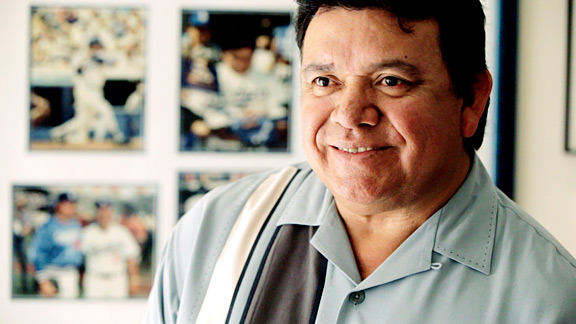
ESPNFernando Valenzuela
ESPN’s strong “30 for 30” sports documentary series finds its way to Fernandomania on October 26 with “Fernando Nation,” directed by Cruz Angeles. Here’s the set-up, courtesy of the ESPN press release:
“ ‘The Natural’ is supposed to be a blue-eyed boy who teethed on a 36-ounce Louisville Slugger. He should run like the wind and throw boysenberries through brick. He should come from California.” – Steve Wulf, Sports Illustrated, 1981.
So how was it that a pudgy 20-year-old, Mexican, left-handed pitcher from a remote village in the Sonoran desert, unable to speak a word of English, could sell out stadiums across America and become a rock star overnight? In “Fernando Nation,” Mexican-born and Los Angeles-raised director Cruz Angeles traces the history of a community that was torn apart when Dodger Stadium was built in Chavez Ravine and then revitalized by one of the most captivating pitching phenoms baseball has ever seen. Nicknamed “El Toro” by his fans, Fernando Valenzuela ignited a fire that spread from L.A. to New York—and beyond. He vaulted himself onto the prime-time stage and proved with his signature look to the heavens and killer screwball that the American dream was not reserved for those born on U.S. soil. In this layered look at the myth and the man, Cruz Angeles recalls the euphoria around Fernando’s arrival and probes a phenomenon that transcended baseball for many Mexican-Americans. Fernando Valenzuela himself opens up to share his perspective on this very special time. Three decades later, “Fernandomania” lives.
To be clear, the tearing apart of the community in Chavez Ravine began long before Dodger Stadium entered the picture (see Chapter 11 of “100 Things Dodgers Fans Should Know & Do Before They Die”). In any case, I’m really looking forward to this special.
That Steve Wulf story, by the way, was published in March — a rare national acknowledgment of the potential Valenzuela had before his memorable 1981 season began. Here’s another excerpt: “Valenzuela was born Nov. 1, 1960 in Navojoa on the west coast of Mexico. The Dodgers know this because (Al) Campanis sent Mike Brito, the scout who signed Valenzuela, to Navojoa to pick up his birth certificate. ‘I knew nobody would believe how young he was, unless we got some proof,’ says Campanis.”
* * *
- Here’s what was happening in Sports Illustrated 19 years ago this week.
- Potential trade destinations for Jonathan Broxton are limited, according to this thorough post from Mike Petriello of Mike Scioscia’s Tragic Illness.
- Game 3 of the World Series (scheduled for Saturday, October 30) is set to have a first-pitch time of 3:57 p.m. Pacific, the earliest start time for a World Series game since Game 6 of the 1987 World Series. Chevrolet is essentially underwriting the earlier start time. “We’ve said over the years that if advertisers were willing to support earlier starts at prime time levels, we’d be able to begin games earlier,” FOX Sports president Eric Shanks said.

